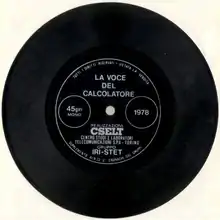MUSA (MUltichannel Speaking Automaton)
MUSA (MUltichannel Speaking Automaton) was an early prototype of Speech Synthesis machine started in 1975.

Description
It consisted of a stand-alone computer hardware and a specialized software that implemented a diphone-synthesis technology. It was one of the first real-time TTS systems. It was able to read Italian in intellegibile robotic voice and also to sing managing up to 8 synthesis channels in parallel thanks to Linear predictive coding technology.[1] In 1978 it was released, after the building of a working prototype,[2] an 45" rpm audio disk containing some trial content of such synthesis, including the song "Fra Martino Campanaro" in "a cappella" (multiple voices) style, attached to some commercial reviews.[3] The experiment was conducted by CSELT, Turin, Italy and was led by Giulio Modena.
Related pages
Notes
- Luciano Nebbia, Paolo Lucchini, Eight-channel digital speech synthesizer based on LPC techniques. ICASSP'79. IEEE International Conference on Acoustics, Speech, and Signal Processing. Vol. 4. IEEE, 1979..
- Roberto Billi, Franco Canavesio, Alberto Ciaramella, & Luciano Nebbia (1995). Interactive voice technology at work: The CSELT experience. Speech communication, 17(3-4), 263-271.
- (it) Virginio Cantoni, Gabriele Falciasecca, Giuseppe Pelosi, eds., Storia delle telecomunicazioni, Vol. 1. Firenze university press, 2011.
References
- Roberto Pieraccini, The voice and the Machine, MIT press, 2015, ISBN 0262533294.